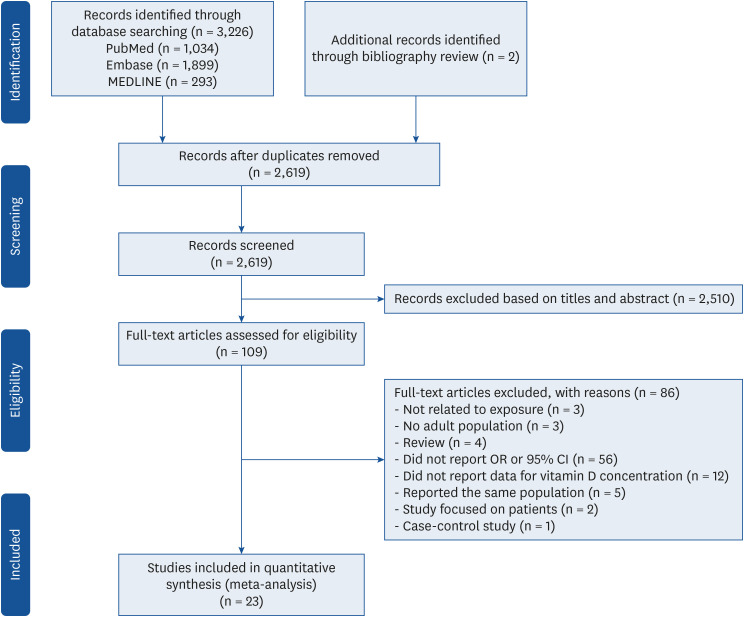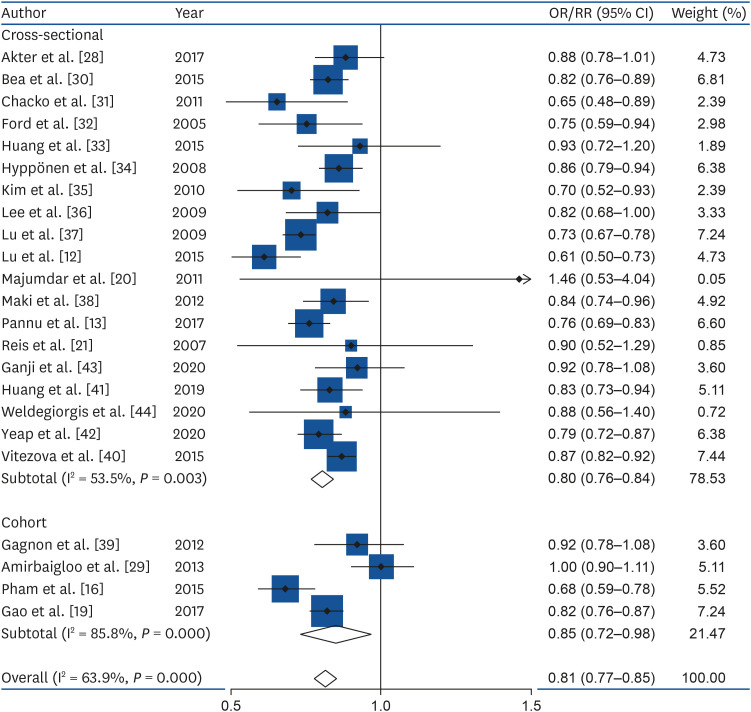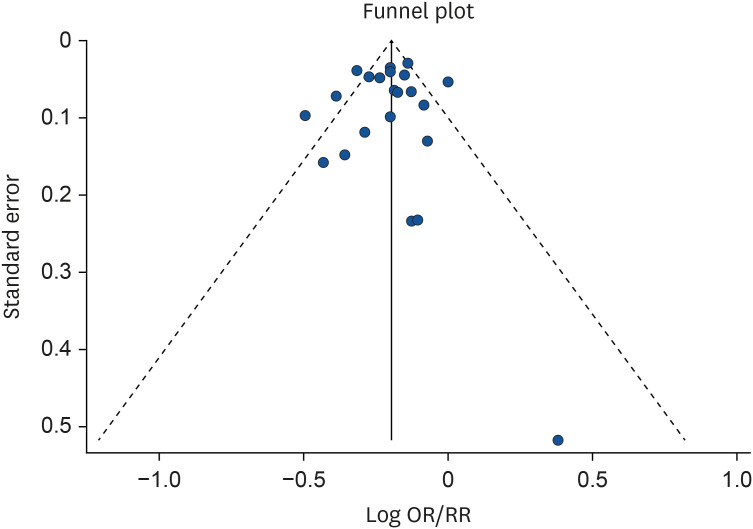Nutr Res Pract.
2021 Jun;15(3):329-345. 10.4162/nrp.2021.15.3.329.
Serum vitamin D status and metabolic syndrome: a systematic review and dose-response meta-analysis
- Affiliations
-
- 1Department of Medical Nutrition, Graduate School of East-West Medical Science, Kyung Hee University, Yongin 17104, Korea
- KMID: 2516072
- DOI: http://doi.org/10.4162/nrp.2021.15.3.329
Abstract
- BACKGROUD/OBJECTIVES: Evidence has suggested an association between serum vitamin D and metabolic syndrome (MetS), but prospective studies are very limited. The objective was to assess the dose-response association between serum vitamin D concentration and MetS risk using a systematic review and meta-analysis of updated observational studies.
MATERIALS/METHODS
Using MEDLINE, PubMed, and Embase, a systematic literature search was conducted through February 2020 and the references of relevant articles were reviewed. A random-effects model was used to estimate the summary odds ratio/relative risk and 95% confidence interval (CI). Heterogeneity among studies was evaluated with I2 statistic. In total, 23 observational studies (19 cross-sectional studies, and four cohort studies) were included in the meta-analysis.
RESULTS
The pooled estimates (95% CI) for MetS per 25-nmol/L increment in serum vitamin D concentration were 0.80 (95% CI, 0.76–0.84; I2 = 53.5) in cross-sectional studies, and 0.85 (95% CI, 0.72–0.98; I2 = 85.8) in cohort studies. Similar results were observed, irrespectively of age of study population, study location, MetS criteria, and adjustment factors. There was no publication bias for the dose-response meta-analysis of serum vitamin D concentrations and MetS.
CONCLUSIONS
Dose-response meta-analysis demonstrated that a 25-nmol/L increment in the serum vitamin D concentration was associated with 20% and 15% lower risks of MetS in cross-sectional studies and cohort studies, respectively.
Figure
Reference
-
1. Holick MF, Chen TC. Vitamin D deficiency: a worldwide problem with health consequences. Am J Clin Nutr. 2008; 87:1080S–1086S. PMID: 18400738.
Article2. Mithal A, Wahl DA, Bonjour JP, Burckhardt P, Dawson-Hughes B, Eisman JA, El-Hajj Fuleihan G, Josse RG, Lips P, Morales-Torres J. IOF Committee of Scientific Advisors (CSA) Nutrition Working Group. Global vitamin D status and determinants of hypovitaminosis D. Osteoporos Int. 2009; 20:1807–1820. PMID: 19543765.
Article3. Wahl DA, Cooper C, Ebeling PR, Eggersdorfer M, Hilger J, Hoffmann K, Josse R, Kanis JA, Mithal A, Pierroz DD, Stenmark J, Stöcklin E, Dawson-Hughes B. A global representation of vitamin D status in healthy populations. Arch Osteoporos. 2012; 7:155–172. PMID: 23225293.
Article4. Palacios C, Gonzalez L. Is vitamin D deficiency a major global public health problem? J Steroid Biochem Mol Biol. 2014; 144(Pt A):138–145. PMID: 24239505.
Article5. Kim M, Na W, Sohn C. Correlation between vitamin D and cardiovascular disease predictors in overweight and obese Koreans. J Clin Biochem Nutr. 2013; 52:167–171. PMID: 23524629.
Article6. Anderson JL, May HT, Horne BD, Bair TL, Hall NL, Carlquist JF, Lappé DL, Muhlestein JB. Intermountain Heart Collaborative (IHC) Study Group. Relation of vitamin D deficiency to cardiovascular risk factors, disease status, and incident events in a general healthcare population. Am J Cardiol. 2010; 106:963–968. PMID: 20854958.
Article7. Botella-Carretero JI, Alvarez-Blasco F, Villafruela JJ, Balsa JA, Vázquez C, Escobar-Morreale HF. Vitamin D deficiency is associated with the metabolic syndrome in morbid obesity. Clin Nutr. 2007; 26:573–580. PMID: 17624643.
Article8. Wilson PW, D'Agostino RB, Parise H, Sullivan L, Meigs JB. Metabolic syndrome as a precursor of cardiovascular disease and type 2 diabetes mellitus. Circulation. 2005; 112:3066–3072. PMID: 16275870.
Article9. Wu SH, Liu Z, Ho SC. Metabolic syndrome and all-cause mortality: a meta-analysis of prospective cohort studies. Eur J Epidemiol. 2010; 25:375–384. PMID: 20425137.
Article10. Borch-Johnsen K. The metabolic syndrome in a global perspective. The public health impact--secondary publication. Dan Med Bull. 2007; 54:157–159. PMID: 17521535.11. Lee SE, Han K, Kang YM, Kim SO, Cho YK, Ko KS, Park JY, Lee KU, Koh EH. Taskforce Team of Diabetes Fact Sheet of the Korean Diabetes Association. Trends in the prevalence of metabolic syndrome and its components in South Korea: findings from the Korean National Health Insurance Service Database (2009–2013). PLoS One. 2018; 13:e0194490. PMID: 29566051.
Article12. Lu Y, Liu M, Pei Y, Li J, Tian H, Cheng X, Fang F, Sun B, Xiao H, Li N, Miao X, Li C. Low levels of serum 25-hydroxyvitamin D and risk of metabolic syndrome in China. Int J Clin Exp Med. 2015; 8:13790–13796. PMID: 26550327.13. Pannu PK, Zhao Y, Soares MJ, Piers LS, Ansari Z. The associations of vitamin D status and dietary calcium with the metabolic syndrome: an analysis of the Victorian Health Monitor survey. Public Health Nutr. 2017; 20:1785–1796. PMID: 27339376.
Article14. Ju SY, Jeong HS, Kim DH. Blood vitamin D status and metabolic syndrome in the general adult population: a dose-response meta-analysis. J Clin Endocrinol Metab. 2014; 99:1053–1063. PMID: 24423309.
Article15. Parker J, Hashmi O, Dutton D, Mavrodaris A, Stranges S, Kandala NB, Clarke A, Franco OH. Levels of vitamin D and cardiometabolic disorders: systematic review and meta-analysis. Maturitas. 2010; 65:225–236. PMID: 20031348.
Article16. Pham TM, Ekwaru JP, Setayeshgar S, Veugelers PJ. The effect of changing serum 25-hydroxyvitamin D concentrations on metabolic syndrome: a longitudinal analysis of participants of a preventive health program. Nutrients. 2015; 7:7271–7284. PMID: 26343719.
Article17. Modesti PA, Reboldi G, Cappuccio FP, Agyemang C, Remuzzi G, Rapi S, Perruolo E, Parati G. ESH Working Group on CV Risk in Low Resource Settings. Panethnic differences in blood pressure in Europe: a systematic review and meta-analysis. PLoS One. 2016; 11:e0147601. PMID: 26808317.
Article18. Greenland S, Longnecker MP. Methods for trend estimation from summarized dose-response data, with applications to meta-analysis. Am J Epidemiol. 1992; 135:1301–1309. PMID: 1626547.
Article19. Gao Y, Ran X, Ren Y, Chen T, Zheng T, Zhong L, Tian H. Relationship between vitamin D level and the incidence of metabolic syndrome in adults in Chengdu city: a prospective cohort study. Chin J Evid-Based Med. 2017; 17:1121–1126.20. Majumdar V, Nagaraja D, Christopher R. Vitamin D status and metabolic syndrome in Asian Indians. Int J Obes. 2011; 35:1131–1134.
Article21. Reis JP, von Mühlen D, Kritz-Silverstein D, Wingard DL, Barrett-Connor E. Vitamin D, parathyroid hormone levels, and the prevalence of metabolic syndrome in community-dwelling older adults. Diabetes Care. 2007; 30:1549–1555. PMID: 17351276.
Article22. Orsini N, Bellocco R, Greenland S. Generalized least squares for trend estimation of summarized dose-response data. Stata J. 2006; 6:40–57.
Article23. Higgins JP, Thompson SG. Quantifying heterogeneity in a meta-analysis. Stat Med. 2002; 21:1539–1558. PMID: 12111919.
Article24. Higgins JP, Thompson SG, Deeks JJ, Altman DG. Measuring inconsistency in meta-analyses. BMJ. 2003; 327:557–560. PMID: 12958120.
Article25. Egger M, Davey Smith G, Schneider M, Minder C. Bias in meta-analysis detected by a simple, graphical test. BMJ. 1997; 315:629–634. PMID: 9310563.
Article26. Begg CB, Mazumdar M. Operating characteristics of a rank correlation test for publication bias. Biometrics. 1994; 50:1088–1101. PMID: 7786990.
Article27. Furuya-Kanamori L, Barendregt JJ, Doi SA. A new improved graphical and quantitative method for detecting bias in meta-analysis. Int J Evid-Based Healthc. 2018; 16:195–203. PMID: 29621038.
Article28. Akter S, Eguchi M, Kurotani K, Kochi T, Kashino I, Ito R, Kuwahara K, Tsuruoka H, Kabe I, Mizoue T. Serum 25-hydroxyvitamin D and metabolic syndrome in a Japanese working population: the Furukawa Nutrition and Health Study. Nutrition. 2017; 36:26–32. PMID: 28336104.
Article29. Amirbaigloo A, Hosseinpanah F, Sarvghadi F, Tohidi M, Eskandary PS, Azizi F. Absence of association between vitamin D deficiency and incident metabolic syndrome: Tehran Lipid and Glucose Study. Metab Syndr Relat Disord. 2013; 11:236–242. PMID: 23496029.
Article30. Bea JW, Jurutka PW, Hibler EA, Lance P, Martínez ME, Roe DJ, Sardo Molmenti CL, Thompson PA, Jacobs ET. Concentrations of the vitamin D metabolite 1,25(OH)2D and odds of metabolic syndrome and its components. Metabolism. 2015; 64:447–459. PMID: 25496802.
Article31. Chacko SA, Song Y, Manson JE, Van Horn L, Eaton C, Martin LW, McTiernan A, Curb JD, Wylie-Rosett J, Phillips LS, Plodkowski RA, Liu S. Serum 25-hydroxyvitamin D concentrations in relation to cardiometabolic risk factors and metabolic syndrome in postmenopausal women. Am J Clin Nutr. 2011; 94:209–217. PMID: 21613558.
Article32. Ford ES, Ajani UA, McGuire LC, Liu S. Concentrations of serum vitamin D and the metabolic syndrome among U.S. adults. Diabetes Care. 2005; 28:1228–1230. PMID: 15855599.
Article33. Huang CY, Chang HH, Lu CW, Tseng FY, Lee LT, Huang KC. Vitamin D status and risk of metabolic syndrome among non-diabetic young adults. Clin Nutr. 2015; 34:484–489. PMID: 24953770.
Article34. Hyppönen E, Boucher BJ, Berry DJ, Power C. 25-hydroxyvitamin D, IGF-1, and metabolic syndrome at 45 years of age: a cross-sectional study in the 1958 British Birth Cohort. Diabetes. 2008; 57:298–305. PMID: 18003755.
Article35. Kim MK, Il Kang M, Won Oh K, Kwon HS, Lee JH, Lee WC, Yoon KH, Son HY. The association of serum vitamin D level with presence of metabolic syndrome and hypertension in middle-aged Korean subjects. Clin Endocrinol (Oxf). 2010; 73:330–338. PMID: 20184597.36. Lee DM, Rutter MK, O'Neill TW, Boonen S, Vanderschueren D, Bouillon R, Bartfai G, Casanueva FF, Finn JD, Forti G, Giwercman A, Han TS, Huhtaniemi IT, Kula K, Lean ME, Pendleton N, Punab M, Silman AJ, Wu FC. European Male Ageing Study Group. Vitamin D, parathyroid hormone and the metabolic syndrome in middle-aged and older European men. Eur J Endocrinol. 2009; 161:947–954. PMID: 19773367.
Article37. Lu L, Yu Z, Pan A, Hu FB, Franco OH, Li H, Li X, Yang X, Chen Y, Lin X. Plasma 25-hydroxyvitamin D concentration and metabolic syndrome among middle-aged and elderly Chinese individuals. Diabetes Care. 2009; 32:1278–1283. PMID: 19366976.
Article38. Maki KC, Fulgoni VL 3rd, Keast DR, Rains TM, Park KM, Rubin MR. Vitamin D intake and status are associated with lower prevalence of metabolic syndrome in U.S. adults: National Health and Nutrition Examination Surveys 2003–2006. Metab Syndr Relat Disord. 2012; 10:363–372. PMID: 22793651.
Article39. Gagnon C, Lu ZX, Magliano DJ, Dunstan DW, Shaw JE, Zimmet PZ, Sikaris K, Ebeling PR, Daly RM. Low serum 25-hydroxyvitamin D is associated with increased risk of the development of the metabolic syndrome at five years: results from a national, population-based prospective study (the Australian Diabetes, Obesity and Lifestyle Study: AusDiab). J Clin Endocrinol Metab. 2012; 97:1953–1961. PMID: 22442263.
Article40. Vitezova A, Zillikens MC, van Herpt TT, Sijbrands EJ, Hofman A, Uitterlinden AG, Franco OH, Kiefte-de Jong JC. Vitamin D status and metabolic syndrome in the elderly: the Rotterdam Study. Eur J Endocrinol. 2015; 172:327–335. PMID: 25468955.
Article41. Huang H, Guo J, Chen Q, Chen X, Yang Y, Zhang W, Liu Y, Chen X, Yang D. The synergistic effects of vitamin D and estradiol deficiency on metabolic syndrome in Chinese postmenopausal women. Menopause. 2019; 26:1171–1177. PMID: 31188285.
Article42. Yeap BB, Dedic D, Budgeon CA, Murray K, Knuiman MW, Hunter M, Zhu K, Cooke BR, Lim EM, Mulrennan S, Walsh JP, Green DJ. U-shaped association of vigorous physical activity with risk of metabolic syndrome in men with low lean mass, and no interaction of physical activity and serum 25-hydroxyvitamin D with metabolic syndrome risk. Intern Med J. 2020; 50:460–469. PMID: 31161619.
Article43. Ganji V, Sukik A, Alaayesh H, Rasoulinejad H, Shraim M. Serum vitamin D concentrations are inversely related to prevalence of metabolic syndrome in Qatari women. Biofactors. 2020; 46:180–186. PMID: 31512799.
Article44. Weldegiorgis TZ, Hidru TH, Yang XL, Xia YL, Ma L, Li HH. Association between serum 25-hydroxyvitamin D concentrations and metabolic syndrome in the middle-aged and elderly Chinese population in Dalian, northeast China: a cross-sectional study. J Diabetes Investig. 2020; 11:184–191.45. Khan H, Kunutsor S, Franco OH, Chowdhury R. Vitamin D, type 2 diabetes and other metabolic outcomes: a systematic review and meta-analysis of prospective studies. Proc Nutr Soc. 2013; 72:89–97. PMID: 23107484.
Article46. Khosravi ZS, Kafeshani M, Tavasoli P, Zadeh AH, Entezari MH. Effect of vitamin D supplementation on weight loss, glycemic indices, and lipid profile in obese and overweight women: a clinical trial study. Int J Prev Med. 2018; 9:63. PMID: 30123437.
Article47. Salekzamani S, Mehralizadeh H, Ghezel A, Salekzamani Y, Jafarabadi MA, Bavil AS, Gargari BP. Effect of high-dose vitamin D supplementation on cardiometabolic risk factors in subjects with metabolic syndrome: a randomized controlled double-blind clinical trial. J Endocrinol Invest. 2016; 39:1303–1313. PMID: 27400997.
Article48. Talaei A, Mohamadi M, Adgi Z. The effect of vitamin D on insulin resistance in patients with type 2 diabetes. Diabetol Metab Syndr. 2013; 5:8. PMID: 23443033.
Article49. Griffin FC, Gadegbeku CA, Sowers MR. Vitamin D and subsequent systolic hypertension among women. Am J Hypertens. 2011; 24:316–321. PMID: 21088670.
Article50. Chiu KC, Chu A, Go VL, Saad MF. Hypovitaminosis D is associated with insulin resistance and beta cell dysfunction. Am J Clin Nutr. 2004; 79:820–825. PMID: 15113720.51. Liu HX, Wang YM, Hu JP, Huang LY, Fang NY. Adipocyte differentiation is regulated by mitochondrial trifunctional protein α-subunit via sirtuin 1. Exp Cell Res. 2017; 357:271–281. PMID: 28552586.
Article52. Ye X, Li M, Hou T, Gao T, Zhu WG, Yang Y. Sirtuins in glucose and lipid metabolism. Oncotarget. 2017; 8:1845–1859. PMID: 27659520.
Article53. Chang E, Kim Y. Vitamin D decreases adipocyte lipid storage and increases NAD-SIRT1 pathway in 3T3-L1 adipocytes. Nutrition. 2016; 32:702–708. PMID: 26899162.
Article54. Vaidya A, Williams JS. The relationship between vitamin D and the renin-angiotensin system in the pathophysiology of hypertension, kidney disease, and diabetes. Metabolism. 2012; 61:450–458. PMID: 22075270.
Article55. Li YC. Vitamin D regulation of the renin-angiotensin system. J Cell Biochem. 2003; 88:327–331. PMID: 12520534.
Article56. Pilz S, Tomaschitz A, März W, Drechsler C, Ritz E, Zittermann A, Cavalier E, Pieber TR, Lappe JM, Grant WB, Holick MF, Dekker JM. Vitamin D, cardiovascular disease and mortality. Clin Endocrinol (Oxf). 2011; 75:575–584. PMID: 21682758.
Article57. Pilz S, Tomaschitz A, Drechsler C, Ritz E, Boehm BO, Grammer TB, März W. Parathyroid hormone level is associated with mortality and cardiovascular events in patients undergoing coronary angiography. Eur Heart J. 2010; 31:1591–1598. PMID: 20439261.
Article58. Snijder MB, Lips P, Seidell JC, Visser M, Deeg DJ, Dekker JM, van Dam RM. Vitamin D status and parathyroid hormone levels in relation to blood pressure: a population-based study in older men and women. J Intern Med. 2007; 261:558–565. PMID: 17547711.
Article59. Ahlström T, Hagström E, Larsson A, Rudberg C, Lind L, Hellman P. Correlation between plasma calcium, parathyroid hormone (PTH) and the metabolic syndrome (MetS) in a community-based cohort of men and women. Clin Endocrinol (Oxf). 2009; 71:673–678. PMID: 19250270.
Article60. Garbossa SG, Folli F. Vitamin D, sub-inflammation and insulin resistance. A window on a potential role for the interaction between bone and glucose metabolism. Rev Endocr Metab Disord. 2017; 18:243–258. PMID: 28409320.
Article61. Neve A, Corrado A, Cantatore FP. Immunomodulatory effects of vitamin D in peripheral blood monocyte-derived macrophages from patients with rheumatoid arthritis. Clin Exp Med. 2014; 14:275–283. PMID: 23824148.
Article62. Giulietti A, van Etten E, Overbergh L, Stoffels K, Bouillon R, Mathieu C. Monocytes from type 2 diabetic patients have a pro-inflammatory profile. 1,25-dihydroxyvitamin D(3) works as anti-inflammatory. Diabetes Res Clin Pract. 2007; 77:47–57. PMID: 17112620.
- Full Text Links
- Actions
-
Cited
- CITED
-
- Close
- Share
- Similar articles
-
- Vitamin D and Metabolic Diseases: Growing Roles of Vitamin D
- Impact of ABCB1 C3435T Polymorphism on Treatment Response of Vitamin K Antagonists: A Systematic Review and Meta-analysis
- The role of vitamin D deficiency on COVID-19: a systematic review and meta-analysis of observational studies
- An Introduction of the Systematic Review and Meta-Analysis
- Systematic Review of the roles of Inositol and Vitamin D in improving fertility among patients with Polycystic Ovary Syndrome





